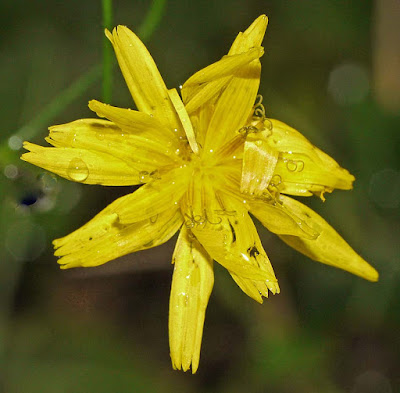Just sent in my list of species that I found flowering today for the BSBI New Year Plant Hunt (see bottom of this post), after walking the cliffs from Seaham to Hawthorn Dene on the Durham coast,
Despite the mild winter so far it's not a very impressive list - just 14 species. For almost all of them, I'd be surprised if I didn't find them flowering at this time of year, with one exception.
The only really interesting species in the list is yellow-wort Blackstonia perfoliata. There were scores of plants flowering around the old
limestone quarry near Hawthorn Dene. Some were undoubtedly second generation
plants that were progeny of individuals that flowered early last summer and
these late bloomers have benefited from the mild autumn to reach flowering size and set seed,
probably pollinated by small flies attracted to the yellow flowers.
There were
also some robust non-flowering plants that were undamaged by last night's frost
and may well survive the winter, to flower very early in 2016.
B. perfoliata,
with it's annual life cycle and overlapping generations, could be a
species whose fitness, in terms of overall annual capacity to reproduce, might be
enhanced by warmer winters.
It seems likely that there might be at least five main types of plants that are in flower at this time of year:
1. Occasional mutants whose flowering control mechanisms for responding to temperature and/or daylength have been disrupted. A classic example might be the Glastonbury thorn mutant of hawthorn. A number of horticultural mutants e.g. winter-flowering pansies and primrose species fall into this category too.
2. The hangers-on: late summer/autumn-flowering species that continue to flower sporadically if the weather isn't too severe. In genetically variable species there are always likely to be some plants that are more likely than others to perform in this way.
3. Spring-flowering species whose blooming is genuinely brought forward by mild winters e.g spurge laurel, blackthorn and sweet violet
4. Species that have always flowered all year-round anyway and don't need any pollinators e.g. groundsel.
5. Species that might be showing an adaptive response, taking advantage of a changing winter climate. Species are only likely to benefit from this (i.e. have increased fitness, in the sense of leaving more progeny) if they have non-specific pollination requirements and yellow-wort fits this category rather well, since its yellow flowers are attractive to small flies, that are present even in winter and are active on milder days.
Species flowering at Seaham today:
Yellow-wort Blackstonia perfoliata
Wood avens Geum urbanum
Red dead-nettle Lamium purpureum
Ragwort Senecio jacobaea
Common daisy Bellis perennis
Sow thistle Sonchus oleraceus
Gorse Ulex europaeus
Winter heliotrope Petasites fragrans
Bramble Rubus fruticosus agg.
Dandelion Taraxacum officinale agg.
Groundsel Senecio vulgaris
Annual meadow grass Poa annua
Herb Robert Geranium robertianum
Ox-eye daisy Leucanthemum vulgare





















































